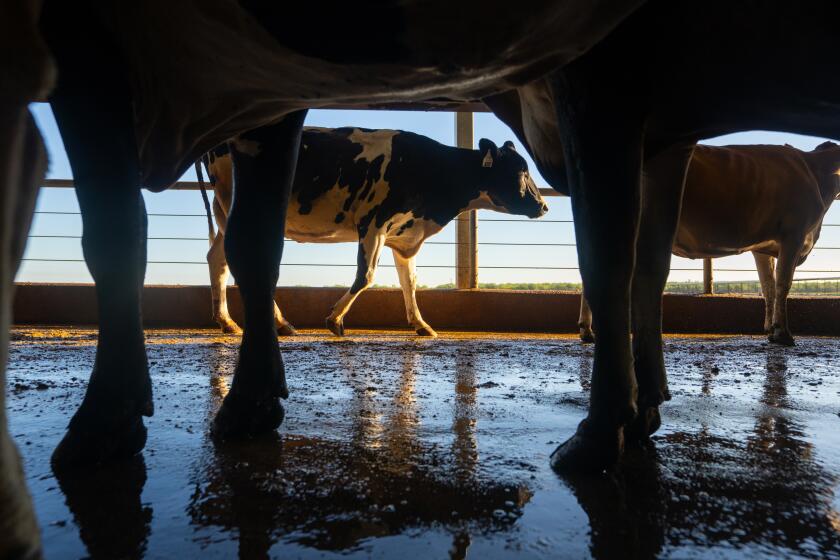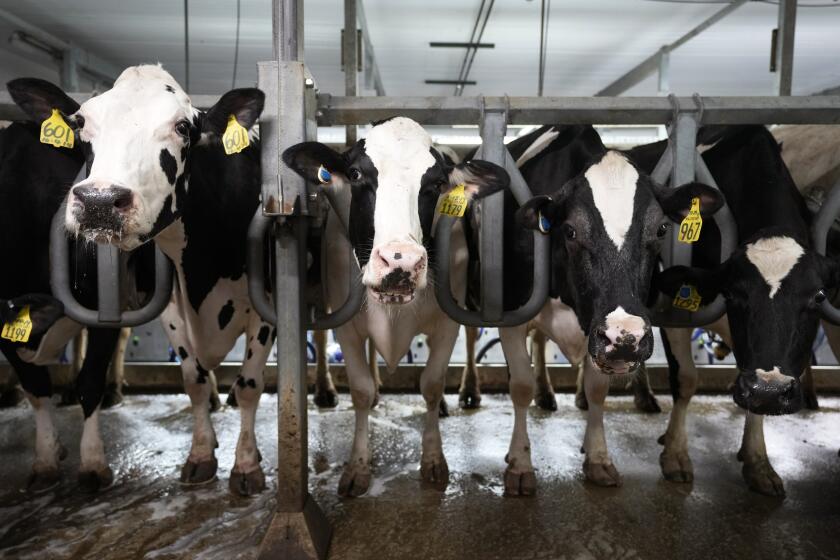Why scientists say we are fighting H5N1 bird flu with one hand tied behind our backs

- Gain-of-function research became controversial during the COVID-19 pandemic.
- But without it, “we’re just flying in the dark” when it comes to H5N1, said Felicia Goodrum, a molecular virologist at the University of Arizona.
As the H5N1 bird flu virus steamrolls its way across the globe — killing wild animals, commercial livestock and even some people — scientists and health officials fear we’re on the precipice of another global pandemic.
But when, where and how that could come to pass is hard to predict — in part, some researchers say, because of guardrails the federal government has placed around gain-of-function research.
The term describes experiments that seek to understand a virus’ potential to adapt to new hosts, spread more easily, survive longer in the environment and cause those infected to become sicker. Though many scientists view the approach as a critical tool for conducting biological research, other experts have long complained that it’s unacceptably risky — a reputation exacerbated by persistent speculation that the virus responsible for the COVID-19 pandemic was created in gain-of-function experiments in a laboratory in Wuhan, China.
That led many virologists to steer clear of the work to avoid its stigma and regulatory red tape. Some in the field say that has deprived officials of valuable information that could have helped them anticipate and prepare for H5N1’s next moves.
“Do I believe if that research was more widely accepted, we’d have a better grip on this virus and what it might do next? Or how quickly it could change? Or what that would take?” asked Richard Webby, director of the World Health Organization’s Collaborating Center for Studies on the Ecology of Influenza in Animals and Birds. “YES.”
Felicia Goodrum, a molecular virologist at the University of Arizona, said gain-of-function research could enable health officials to recognize worrisome H5N1 mutations and identify targets for antivirals and vaccines.
“Without it, we’re just flying in the dark,” she said.
The Scripps Research Institute finding counters prevailing thought that the virus would require multiple mutations before it poses a threat to public health.
Critics of this line of research don’t see it that way. They say the work is too dangerous, making it possible for a souped-up pathogen to escape into the environment where people have no natural immunity. Even worse, they argue, it could wind up in the hands of nefarious actors who could use it as a bioweapon.
These risks outweigh the promise of work that may not be as helpful as its supporters suggest, said Marc Lipsitch, professor of epidemiology at the Harvard T.H. Chan School of Public Health.
What scientists and health officials need to know to contain the outbreak, Lipsitch argues, are things like which animals are infected, which people have been exposed, how many of them caught the virus and how sick they became as a result.
“Those are basic epidemiology and veterinary questions,” Lipsitch said. “I can’t think of any route by which gain-of-function studies could have informed — much less answered — those questions.”

The controversy dates to 2011, when two independent research groups said they had conducted gain-of-function experiments that resulted in strains of H5N1 that could be spread via air between ferrets, a species used to model influenza’s behavior in humans.
H5N1 was first identified in wild geese in China in 1996 and soon spread among birds in Asia, jumping to people on hundreds of occasions along the way. More than half of those known infections were fatal.
The high mortality rate and geographical spread of the virus prompted then-President George W. Bush to establish a $7.1-billion program to prepare for its inevitable arrival on U.S. shores. He spearheaded the establishment of a global surveillance and preparedness network via the WHO, as well as a national one. He also directed federal funds into the stockpile of vaccines and antiviral medications, as well as millions of dollars toward laboratory research.
For the avian flu to reach North America -- and there is no known way to stop it -- all it will take is an infected bird’s migration.
Amid this flood of support, Yoshihiro Kawaoka‘s team at the University of Wisconsin in Madison and Ron Fouchier‘s at Erasmus University in the Netherlands simultaneously began to experiment with H5N1, introducing genetic mutations into its RNA to see what changes could transform it from a virus that passed easily between birds into one that passed efficiently between people.
Kawaoka and his colleagues combined the H5 hemagglutinin gene from the bird flu virus with genes from the 2009 H1N1 swine flu virus. Then they coaxed their hybrid to evolve in a way that allowed it to bind with mammalian cells rather than bird cells. They found that four mutations in the H5 gene were enough to create a virus capable of spreading between ferrets in neighboring cages.
Meanwhile, the researchers in Fouchier’s lab tinkered solely with H5N1. They added a handful of mutations that helped fuel previous flu pandemics, then infected their ferrets. The virus didn’t spread on its own at first, so the scientists helped it along by transferring it from the noses of infected animals to healthy ferrets. After 10 such passages, the virus had evolved to the point where it spread on its own from one ferret to another.
The studies offered valuable confirmation that the bird flu virus had the potential to spark a human pandemic, said Dr. Arturo Casadevall, an immunologist and infectious disease physician at Johns Hopkins University.
“Before those experiments were done, we did not know whether H5N1 had the biological capacity to become mammalian-transmissible,” he said.
But they also underscored the risk that scientists could accelerate the threat. “That was the original gain-of-function poster child,” Casadevall said.
A Californian recently became the first child in the U.S. to be infected. It looks like a matter of when, not if, this will spread faster among humans.
Concern that information in the studies could be put to ill use prompted Kawaoka and Fouchier to voluntarily pause their work in 2012, and their papers were published only after passing a thorough safety review by the U.S. National Science Advisory Board for Biosecurity. Gain-of-function research resumed the following year.
Fears were revived in 2014 after federal labs mishandled samples of smallpox, anthrax and H5N1. Nobody was sickened, but it prompted a three-year freeze on federal funding for gain-of-function experiments involving particularly dangerous pathogens, until stricter oversight rules were put in place.
Plans for such experiments now go through several layers of review at a potential researcher’s institution. If the work is funded by the National Institutes of Health, additional reviews follow.
“There are a lot of regulatory hurdles to assure there’s appropriate risk mitigation,” said Seema Lakdawala, a virologist at Emory University who studies influenza viruses. “We’re all being extra careful because nobody wants to be accused of having done something unsafe.”

Those hurdles can delay a research project by several months or more, if they are approved at all, she said. The uncertainties have acted as a deterrent, especially for scientists in the early stages of their careers.
“It’s definitely uncomfortable to do gain-of-function research,” Goodrum said. “We’re discouraging people from entering the field.”
To some, the timing couldn’t be worse.
At least 65 people in the U.S. have been infected with H5N1 since it arrived in North America in 2021, according to the Centers for Disease Control and Prevention. Most of the cases have involved workers on dairy and poultry farms, and their symptoms — including conjunctivitis and upper respiratory irritation — have tended to be mild. But in two cases, people have become severely ill, including a person in Louisiana and a teenager in Canada.
Gov. Newsom declares emergency in California after CDC confirms severe case of bird flu in Louisiana
As the CDC confirmed a severe case in Louisiana of a patient hospitalized with H5N1 bird flu, Gov. Gavin Newsom declared a state of emergency in California related to the virus.
There is no evidence that the virus can spread directly from one person to another, the CDC said. Scientists expect that will change sooner or later. With flu season picking up steam, the risk is rising.
“The thing I’m most afraid of today is a recombination event between the stuff going around in cows and the seasonal flu,” Casadevall said. If both viruses infected the same mammal at the same time, their components could mix and match in a way that creates “a strain that is able to infect humans very easily, and for which we don’t have immunity.”
“That is a gain-of-function experiment being done by nature,” he added.
It’s a point that Webby suggested as well, noting that gain-of-function experiments are a whole lot safer in a sealed-off Biosafety Level 3 laboratory equipped with special ventilation systems and other precautions “than on a farm.”
But Lipsitch and others say the fact that the virus is constantly mutating and changing calls into question the relevance of gain-of-function research. A viral strain that can be concocted in a laboratory is not necessarily going to match whatever emerges in the environment.
“There’s a big element of randomness in evolution,” Lipsitch said. “The fact that an experiment goes one way in the lab doesn’t mean it will go the same way somewhere else.”

Even if it’s a close match, Lipsitch said, there’s “compelling evidence that what you learn in one strain can be the opposite for a very closely related strain. So the generalizability is very low.”
He cited a paper that took the mutations that made H5N1 “more mammal-friendly” in Kawaoka’s and Fouchier’s experiments and applied them to a slightly different version of the virus. In that case, the researchers found “a completely different effect.”
These shortcomings make the research risks harder to justify, said Nicholas Evans, a bioethicist at the University of Massachusetts Lowell.
“I think what the gain-of-function debate has yet to answer is, ‘What is the social value of these studies?’” he said.
To Evans, there appears to be very little, especially considering the lack of urgency in the government’s response.
“Saying that this particular piece of extremely niche biological research into H5N1 would have made a material difference in an outbreak that has largely been characterized by a lack of interest on behalf of public federal agricultural and public health regulators just is kind of nonsense to me,” he said.
Kawoaka declined to discuss his research, and Fouchier could not be reached.
Wild birds get the blame, but the largely unregulated transport of cattle across the U.S. poses too-often-ignored disease risks.
Michael Imperiale, a virologist at the University of Michigan in Ann Arbor, said the experiments conducted by Kawaoka and Fouchier are extremely useful as blueprints of what to watch out for as the virus sweeps the globe. And he’s surprised more people aren’t talking about their value.
“No one seems to point out the fact that those gain-of-function experiments ... gave us an important piece of information, which is that that virus can jump,” Imperiale said.
Other gain-of-function experiments conducted on H5N1 years ago have tipped off scientists about potential mutations that could help the real-world virus spread more easily through the air, get better at infecting cells in the mammalian respiratory tract, and become resistant to antiviral medications.
“Those experiments 10 years ago were so informative,” Lakdawala said. “It helped us be better prepared.”
But unless the scientific community stands up for the work and challenges its negative image, that won’t be the case in the future, Goodrum said. “It’s very likely that we will be less prepared for the next pandemic than we were for the last one.”













